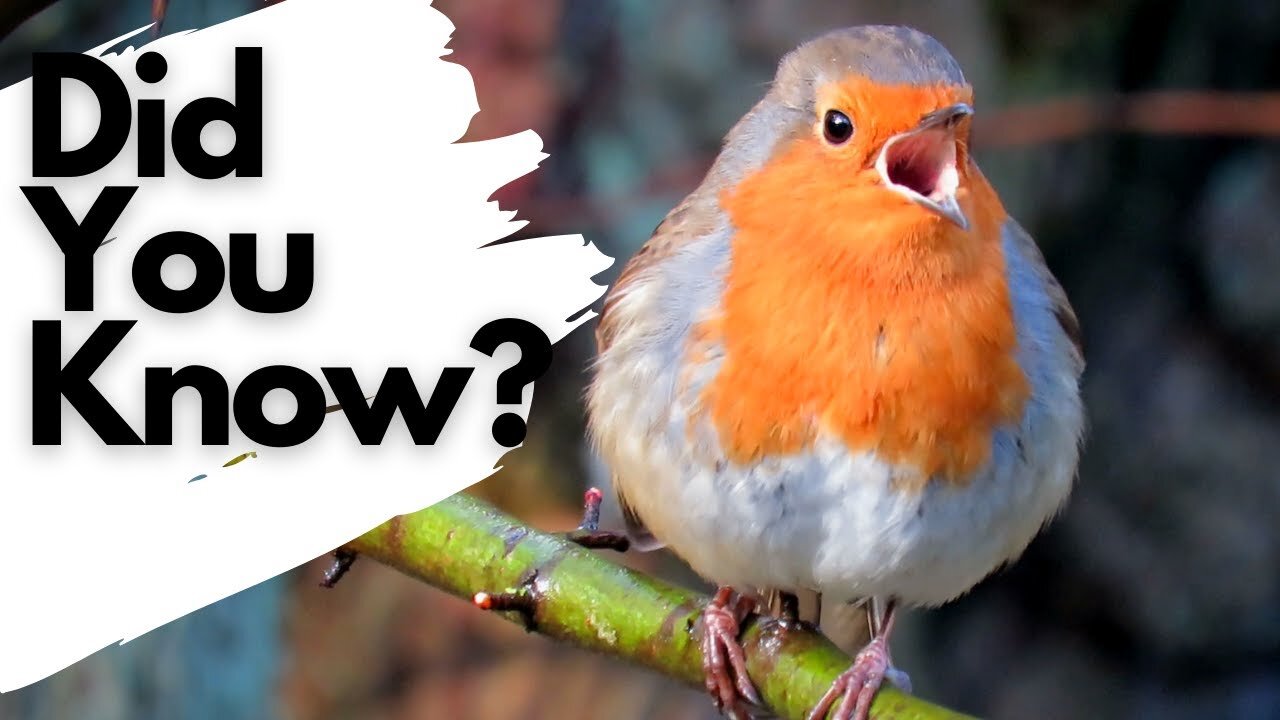Premium Only Content

Things you need to know about ROBINS!
Robins have long been considered as the UKs favourite bird so it is only fitting that they are also the unofficial national bird of the Country. There is some great news for fans of them too as their numbers seem to be on the rise. They are currently the seventh most common garden bird and it is estimated that there are almost seven and a half million of them in the UK.
Robins are quite a small bird, with a 21 cm wingspan and weighing just 14-21 grams. Their most notable feature is their bright red or orange breast and face. They also have brown wings, tails and heads and the feathers on the undersides are white or cream. Despite various suggested ways to tell the males from the females, such as the vibrancy of the red on their breasts, or the darkness of their wing feathers, the truth is that from a distance it is almost impossible to be certain if a robin is male or female. Even their behaviour is not a guarantee as there have been reporting’s of females mounting males during copulation.
Throughout the summer a robins diet mainly consists of invertebrates such as spiders, insects and worms, but during the colder months they will also eat fruit, berries and seed and suet from bird feeding stations. Although they are most common in gardens, parks and deciduous woodlands, they are found in pretty much every habitat.
Despite the difficulties that people may have in separating male and female robins, they don’t seem to have this problem themselves. They spend the late winter roaming outside of their usual territories trying to find a mate and once they do nest building can begin. This usually starts in early march and the nest, a cup of moss and dead leaves lined with hair can be built in the most unusual of places, including empty shoes, under car bonnets, and even in water cans. Naturally they will try to nest close to or on the ground amongst dense vegetation. Each female will lay between 4 and six spotted cream coloured eggs which only the she will incubate alone for 14 days until they hatch. When they do, both parents feed the chicks, who take a further 14 days to leave the nest. It can take more than 14 days for a robin chick to fully grow its flight feathers so sometimes they leave the nest without being able to fly. Young robins are a similar shape and size to their parents but completely lack the red breast. Robins will have 2 or sometimes 3 nests within a season but their nests are very susceptible to predation, only around 57% of the eggs they lay will survive to the point of fledging the nest.
After fledging the nest Robins don’t have a very long life expectancy. The average in the wild is around 2 years but one bird that was ringed in 1969 was found dead 8 years later in 1977. With their close relationship to humans and their adaptability to live in an urban environment, there are currently no threats to Robin populations in the UK.
Some of the footage and images in this video were obtained using creative c
-
 LIVE
LIVE
Nikko Ortiz
45 minutes agoHAMAS Gaza Peace Deal And MORE.... Brutally Honest EP #17 | Rumble LIVE
123 watching -
![Mr & Mrs X - Feminism, Family, Federal Reserve, The Rise Of The [DS] Agenda](https://1a-1791.com/video/fwe2/12/s8/1/6/F/R/n/6FRnz.0kob-small-Mr-and-Mrs-X-Feminism-Famil.jpg) 58:10
58:10
X22 Report
7 hours agoMr & Mrs X - Feminism, Family, Federal Reserve, The Rise Of The [DS] Agenda
164K45 -
 16:37
16:37
Robbi On The Record
1 day ago $5.87 earnedThe Theater of Manufactured Outrage - When Left and Right Dance for the Same Puppet Master
24.1K27 -
 31:27
31:27
Stephen Gardner
19 hours ago🔥BOMBSHELL: Mortician EXPOSES Charlie Kirk Autopsy - The Key Evidence EVERYONE Missed!
112K274 -
 30:00
30:00
BEK TV
3 days agoGUT HEALTH AND THE POWER OF KIMCHI WITH KIM BRIGHT ON TRENT ON THE LOOS
48K4 -
 LIVE
LIVE
IamNibz
9 hours ago $1.47 earned6-7 Minecraft Stream
121 watching -
 36:53
36:53
daniellesmithab
4 days agoSupporting Alberta's Teachers and Students
124K26 -
 1:25:28
1:25:28
VapinGamers
4 hours ago $1.31 earnedTools of the Trade - EP07 Lights, Camera, Go Live with Joker - !rumbot !music
20.2K4 -
 14:38
14:38
Nikko Ortiz
23 hours agoADHD vs Autism
89.1K51 -
 LIVE
LIVE
TonYGaMinG
4 hours ago🟢 INDUSTRIA 2 PLAYTEST / ACTIVE MATTER LATER
126 watching
